Students must start practicing the questions from CBSE Sample Papers for Class 10 Maths Standard with Solutions Set 6 are designed as per the revised syllabus.
CBSE Sample Papers for Class 10 Maths Standard Set 6 with Solutions
Time: 3 hrs
Max. Marks: 80
Instructions:
1. This question paper has 5 Sections A-E.
2. Section A has 20 MCQs carrying 1 mark each.
3. Section B has 5 questions carrying 2 marks each.
4. Section C has 6 questions carrying 3 marks each.
5. Section D has 4 questions carrying 5 marks each.
6. Section E has 3 Case Based integrated units of assessment (4 marks each).
7. All questions are compulsory. However, an internal choice in 2 questions of 2 marks, 2 questions of 3 marks and 2 questions of 5 marks has been provided. An internal choice has been provided in the 2 marks questions of Section E.
8. Draw neat figures wherever required. Take π = 22/7 wherever required if not stated.
Section A
(Section-A consists of 20 Questions of 1 mark each)
Question 1.
If HCF(306, 657) = 9, then LCM (306, 657) is [1]
(a) 22338
(b) 23238
(c) 33228
(d) 32328
Answer:
(a) 22338
We know that
LCM (a, b) × HCF (a, b) = a × b
∴ LCM (306, 657) × HCF (306, 657) = 306 × 657
![]()
= \(\frac{306 \times 657}{9}\) [∵ HCF(306, 657)] = 9
= 22338
Question 2.
The given linear polynomial y = f(x) has: [1]

(a) 2 zeros
(b) 1 zero and the zero is ‘3
(c) 1 zero and the zero is ‘4‘
(d) No zero
Answer:
(b) 1 zero and the zero is ‘3‘
Explanation: The given polynomial y = f(x) has y = 0, at x = 3
Because, given polynomial f(x) and X-axis intersect at points (3, 0).
Question 3.
The value of
2 cos
2
30° + sec
2
30° + 2 cos0° + 3 sin 90° – tan
2
60° is [1]
(a) \(\frac{6}{29}\)
(b) \(\frac{4}{25}\)
(c) \(\frac{29}{6}\)
(d) \(\frac{3}{26}\)
Answer:
(c) \(\frac{29}{6}\)
We have,
2cos
2
30° + sec
2
30° + 2cos0°+ 3sin90° – tan
2
60°
= 2 × \(\left(\frac{\sqrt{3}}{2}\right)^2\) + [atex]\left(\frac{\sqrt{3}}{2}\right)^2[/latex] + 2 × 1 + 3 × 1 – \((\sqrt{3})^2\)
= 2 × \(\frac{3}{4}\) + \(\frac{4}{3}\) + 2 + 3 – 3
= \(\frac{3}{2}\) + \(\frac{4}{3}\) + 2
= \(\frac{9+8+12}{6}\) = \(\frac{23}{9}\)
![]()
Question 4.
Write the nature of roots of the quadratic equation 9x
2
– 6x – 2 = 0.
(a) No real roots
(b) 2 equal real roots
(c) 2 distinct real roots
(d) More than 2 real roots
Answer:
(c) 2 distinct real roots
Explanation: The given quadratic equation:
9x
2
– 6x – 2 = 0
Here, a = 9, b = -6, c = -2
Discriminant, D = b
2
– 4ac
D = (-6)
2
– 4(9) × (- 2)
D = 36 + 72 = 108
∵ D = 108 > 0. The roots are real and distinct.
Question 5.
The sum of probabilities of all the elementary events is [1]
(a) 0
(b) 1
(c) 1.5
(d) None of these
Answer:
(b) 1
The sum of the probability of all the elementary events is always equal to one.
Question 6.
Find the ratio in which the line segment joining (2, – 3) and (5, 6) is divided by X-axis. [1]
(a) 1 : 2
(b) 2 : 1
(c) 2 : 5
(d) 5 : 2
Answer:
(a) 1 : 2
Explanation: Let the line joining points A(2, – 3) and B(5, 6) be divided by X-axis at point P(x, 0) in the ratio (k : 1).
Here, x
1
= 2, y
1
= -3, x
2
= 5, y
2
= 6, m = k, n = 1
y = \(\frac{m y_2+n y_1}{m+n}\)
0 = \(\frac{k \times 6+1 \times-3}{k+1}\)
0 = 6k – 3
k = \(\frac{1}{2}\)
Thus, the required ratio is 1 : 2.
Question 7.
If tan θ = \(\frac{12}{13}\), then the value of \(\frac{2 \sin \theta \cos \theta}{\cos ^2 \theta-\sin ^2 \theta}\) is [1]
(a) \(\frac{312}{25}\)
(b) \(\frac{25}{312}\)
(c) \(\frac{312}{15}\)
(d) \(\frac{15}{312}\)
Answer:
(a) \(\frac{312}{25}\)
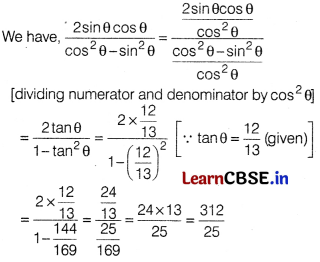
Question 8.
In ΔABC, DE || AB. If AB = a, DE = x, BE = b and EC = c. Express x in terms of a, b and c. [1]

(a) \(\frac{a c}{b}\)
(b) \(\frac{a c}{b+c}\)
(c) \(\frac{a b}{b}\)
(d) \(\frac{a b}{b+c}\)
Answer:
(b) \(\frac{a c}{b+c}\)
Explanation: ΔCED and ΔCBA
∠CED = ∠CBA (DE || AB)
∠DCE = ∠ACB (Common)
∴ ΔCED ~ ΔCBA (By AA similarity)
⇒ \(\frac{\mathrm{EC}}{\mathrm{BC}}=\frac{\mathrm{DE}}{\mathrm{AB}}\) ….. (i)
According to the question,

AB = a, DE = x, BE = b, EC = c
But BC = BE + EC
⇒ BC = b + c
Put the values in equation (i),
⇒ \(\frac{c}{b+c}=\frac{x}{a}\)
⇒ x = \(\frac{a c}{b+c}\)
Question 9.
The value of k, for which 2k + 7, 6k – 2 and 8k + 4 are 3 consecutive terms of an AP [1]
(a) \(\frac{2}{15}\)
(b) \(\frac{2}{17}\)
(c) \(\frac{15}{2}\)
(d) \(\frac{17}{2}\)
Answer:
(c) \(\frac{15}{2}\)
Here, 2k + 7, 6k – 2 and 8k + 4 will be consecutive terms of an AP, if
(6k – 2) – (2k + 7) = (8k + 4) – (6k – 2)
⇒ 4k – 9 = 2k + 6
⇒ 4k – 2k = 9 + 6 ⇒ 2k =15
∴ k = \(\frac{15}{2}\)
Question 10.
Quadrilateral PQRS is drawn to circumscribe a circle.
If PQ = 12 cm, QR = 15 cm and RS = 14 cm, find the length of SP: [1]
(a) 15 cm
(b) 14 cm
(c) 12 cm
(d) 11cm
Answer:
(d) 11 cm
Explanation: Quadrilateral PQRS is drawn to circumscribe a circle.
⇒ PQ, QR, RS and PS are tangent to circle.
∵ Length of tangents drawn to a circle from an external point are equal.
PA = PD …… (i)
AQ = QB …… (ii)
CR = BR ….. (iii)
SC = SD …… (iv)
Adding equations (i), (ii), (iii) and (iv), we get
(PA + AQ) + (CR + SC) = (PD + SD) + (BR + QB)
PQ + RS = PS + QR
Given, PQ = 12 cm, QR = 15 cm, RS = 14 cm, SP = ?
12 + 14 = SP + 15
26 – 15 = SP
SP = 11 cm

Question 11.
The longest diameter of the base of a cone, which can be fully fitted in a cube of edge 8 cm, is [1]
(a) 16 cm
(b) 4 cm
(c) 8 cm
(d) 6 cm
Answer:
(c) 8 cm
The longest diameter of the base of a cone, which can be fully fitted in a cube of edge 8 cm, is 8 cm.
![]()
Question 12.
(sec A + tan A) (1 – sin A) = [1]
(a) sec A
(b) sin A
(c) cosec A
(d) cos A
Answer:
(d) cos A
Explanation:
(sec A + tan A) (1 – sin A) = (\(\frac{1}{\cos A}+\frac{\sin A}{\cos A}\)) (1 – sin A)
= \(\frac{(1+\sin A)}{\cos A} \times \frac{(1-\sin A)}{1}\)
= \(\frac{1-\sin ^2 A}{\cos A}=\frac{\cos ^2 A}{\cos A}\) = cos A (∵ 1 – sin
2
A = cos
2
A)
Question 13.
The algebraic sum of the deviations of a frequency distribution from its mean is [1]
(a) always positive
(b) always negative
(c) zero
(d) a non-zero number
Answer:
(c) zero
Let x
1
, x
2
, x
3
, ……..x
n
be the observations and \(\bar{x}\) its mean. Then,
\(\bar{Z}\)(\(\bar{x}\) – x
i
) = \(\bar{Z}\)\(\bar{x}\) – \(\bar{Z}\)x
i
= n\(\bar{x}\) – n\(\bar{x}\) = 0
Question 14.
If the perimeter and the area of a circle are numerically equal, then the radius of the circle is: [1]
(a) 2 units
(b) π units
(c) 4 units
(d) 7 units
Answer:
(a) 2 units
Explanation: According to the question,
Area of circle = Perimeter of circle
πr
2
= 2πr (∵ r = Radius of circle)
\(\frac{r^2}{r}=\frac{2 \pi}{\pi}\)
⇒ r = 2 units
Question 15.
If ∆ABC and ∆DEF are similar triangles, such that ∠A = 47°, ∠E = 83°, then the value of ∠C is [1]
(a) 0°
(b) 90°
(c) 50°
(d) 45°
Answer:
(c) 50°
Given, ∆ABC ~ ∆DEF
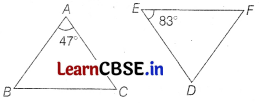
⇒ ∠A = ∠D, ∠B = ∠E, ∠C = ∠F
Given, ∠A = 47° and ∠B = 83°
∴ ∠C = 180° – (∠A + ∠B) = 180° – (47° + 83°) = 50°
Question 16.
There is a green square board of side ‘2a’ unit circumscribing a red circle. Jayadev is asked to keep a dot
(a) \(\frac{\pi}{4}\)
(b) \(\frac{4-\pi}{4}\)
(c) \(\frac{\pi-4}{4}\)
(d) \(\frac{4}{\pi}\)
Answer:
(b) \(\frac{4-\pi}{4}\)
Explanation:
Area of green square board = 2a × 2a = 4a
2
Thus, n(s) = 4a
2
A = Area of abovesaid board
n(A) = Area of green square – Area of red circle
= 4a
2
– πa
2
= (4 – π)a
2
Required probability, P(A) = \(\frac{n(\mathrm{~A})}{n(\mathrm{~S})}\)
P(A) = \(\frac{(4-\pi) a^2}{4 a^2}\)
P(A) = \(\frac{4-\pi}{4}\)

Question 17.
Tours for the national capital and the white house begin at 8:30 am from tour agency. Tours for the national capital leave every 15 min. Tours for the white house leave every 20 min. How many minutes after do the tours leave at the same time? [1]
(a) 60 min
(b) 30 min
(c) 80 min
(d) 100 min
Answer:
(a) 60 min
Required time LCM (15, 20)
By using prime factorisation method,
15 = 3 × 5
and 20 = 2 × 2 × 5 = 2
2
× 5
∴ LCM (15, 20) = 2
2
× 3 × 5 = 60 min
Every 60 min. tours leave at the same time.
Question 18.
Find the upper limit of the modal class from the given distribution. [1]

(a) 165
(b) 160
(c) 155
(d) 150
Answer:
(d) 150
Explanation: According to the question, Frequency distribution becomes.
Maximum frequency = 18
Hence, Modal Class = (145 – 150)
Upper limit of modal class = 150
Direction In question number 19 and 20, a statement of Assertion (A) is followed by a statement of Reason (R). Choose the correct option.
Question 19.
Assertion (A) The class mark of the class 15-35 is 25.
Reason (R) The class mark is the difference of upper class limit and the lower class limit.
(a) Both Assertion (A) and Reason (R) are true and Reason (R) is the correct explanation of Assertion (A).
(b) Both Assertion (A) and Reason (R) are true but Reason (R) is not the correct explanation of Assertion (A).
(c) Assertion (A) is true but Reason (R) is false.
(d) Assertion (A) is false but Reason (R) is true. [1]
Answer:
(c) Assertion (A) is true but Reason (R) is false.
We know that class mark of a class is the mid-point of a class i.e. Class mark
\(=\frac{\text { Upper class limit }+ \text { Lower class limit }}{2}\)
For class 15-35, class mark = \(\frac{35+15}{2}\) = \(\frac{50}{2}\) = 25
So, the given Assertion (A) is true.
We know that class size is the difference of upper class limit and lower class limit.
So, the given Reason (R) is false.
Hence, Assertion (A) is true but Reason (R) is false.
Question 20.
Statement A (Assertion): -5, \(\frac{-5}{2}\), 0, \(\frac{5}{2}\) ….. is in Arithmetic Progression.
Statement R (Reason): The terms of an Arithmetic Progression cannot have both positive and negative rational numbers. [1]
Answer:
(c) Assertion (A) is true, but reason (R) is false.
Explanation: ∵ The common difference between the consecutive terms is equal in A.P.
T
2
– T
1
= T
3
– T
2
= T
4
– T
3
\(\frac{-5}{2}\) + 5 = 0 + \(\frac{5}{2}\) = \(\frac{5}{2}\) – 0
\(\frac{5}{2}\) = \(\frac{5}{2}\) = \(\frac{5}{2}\)
Hence, Statement A is true.
∵ The terms of an arithmetic progression can have both positive and negative rational numbers.
Hence reason R is false.
![]()
Section B
(Section B consists of 5 questions of 2 marks each.)
Question 21.
ABCD is a trapezium with AB || DC. If ∆AED is similar to ∆BEC, then prove that AD = BC. [2]
Answer:
Given Trapezium ABCD in which AB || DC and ∆AED ~ ∆BEC.
To prove AD = BC
Proof In ∆EDC and ∆EBA,
∠CED = ∠AEB [vertically opposite angles]
∠EDC = ∠EBA [alternate interior angles]
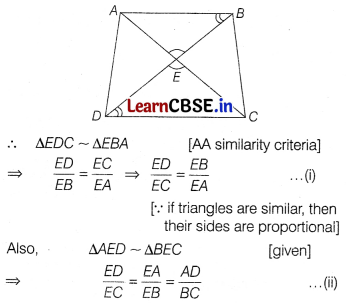
[∵ if triangles are similar, then their sides are proportional]
From Eqs. (i) and (ii), we get
\(\frac{E B}{E A}\) = \(\frac{E A}{E B}\)
⇒ (EB)
2
= (EA)
2
⇒ EB = EA [taking positive square root]
From Eq. (ii), we get
\(\frac{E B}{E A}\) = \(\frac{A D}{B C}\) ⇒ \(\frac{A D}{B C}\) = 1 [∵ EB = EA]
∴ AD = BC Hence proved.
Or
Find the length of the median drawn through A on BC of an ∆ABC, whose vertices are A(7, – 3), B(5, 3), and C(3, -1).
Answer:
The median from the vertex of a triangle bisects the opposite side.
So, let AD be the median through A then D must be the mid-point of the side BC.
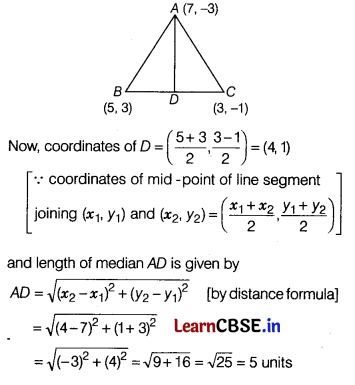
Question 22.
ABCD is a parallelogram. Point P divides AB in the ratio 2 : 3 and point Q divides DC in the ratio 4 : 1. Prove that OC is half of OA. [2]

Solution:
ABCD is a parallelogram.
AB = DC = a
Point P divides AB in the ratio 2 : 3
AP = \(\frac{2}{5}\)a, BP = \(\frac{3}{5}\)a
Point Q divides DC in the ratio 4 : 1
DQ = \(\frac{4}{5}\)a, CQ = \(\frac{1}{5}\)a

In ΔAPO and ΔCQO
∠APO = ∠CQO (AP || QC)
∠AOP = ∠COQ (Vertically opposite angles)
Then, ΔAPO ~ ΔCQO (AA similarity)
\(\frac{\mathrm{AP}}{\mathrm{CQ}}=\frac{\mathrm{PO}}{\mathrm{QO}}=\frac{\mathrm{AO}}{\mathrm{CO}}\)
\(\frac{\mathrm{AO}}{\mathrm{CO}}=\frac{\frac{2}{5} a}{\frac{1}{5} a}=\frac{2}{1}\) ⇒ OC = \(\frac{1}{2}\) OA Hence proved.
Question 23.
Prove that
sec A (1 – sin A) (sec A + tan A) = 1 [2]
Answer:
LHS = sec A(1 – sin A)(sec A + tan A)
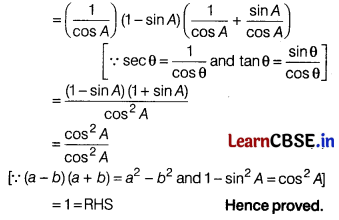
Question 24.
If tan (A + B) = √3 and tan (A – B) = \(\frac{1}{\sqrt{3}}\); 0° < A + B < 90°; A > B, find A and B. [2]
OR
Find the value of x.
2 cosec
2
30 + x sin
2
60 – \(\frac{3}{4}\) tan
2
30 = 10
Solution:
∵ tan (A + B) = √3
∴ A + B = 60° ……… (i)
∵ tan (A – B) = \(\frac{1}{\sqrt{3}}\)
∴ A – B = 30° ……… (ii)
Adding (i) and (ii), we get 2A = 90° ⇒ A = 45°
Also (i) – (ii), we get 2B = 30° ⇒ B = 15°
OR
2 cosec
2
30 + x sin
2
60 – \(\frac{3}{4}\) tan
2
30 = 10
⇒ 2(2)
2
+ x(\(\frac{\sqrt{3}}{2}\))
2
– \(\frac{3}{4}\) (\(\frac{1}{\sqrt{3}}\))
2
= 10
⇒ 2(4) + x(\(\frac{3}{4}\)) – \(\frac{3}{4}\) (\(\frac{1}{3}\)) = 10
⇒ 8 + x (\(\frac{3}{4}\)) – \(\frac{1}{4}\) = 10
⇒ 32 + 3x – 1 = 40
⇒ 3x = 9 ⇒ x = 3
Question 25.
5 yr hence, the age of Jacob will be three times that of his son. 5 yr ago, Jacob’s age was seven times that of his son. What are their present ages? [2]
Answer:
Let the present age of Jacob be x yr and the present age of his son be y yr.
5 yr hence, Jacob’s age =(x + 5) yr
and his son’s age = (y + 5) yr
By the first condition.
(x + 5) = 3(y + 5)
⇒ x + 5 = 3y + 15
⇒ x = 3y + 15 – 5
⇒ x = 3y + 10 …… (i)
5 yr ago, Jacob’s age = (x – 5) yr
and his son’s age = (y – 5)yr
By the second condition,
(x – 5) = 7 (y – 5)
⇒ x – 5 = 7y – 35
⇒ x = 7y – 35 + 5
⇒ x – 7y = -30 ……..(ii)
On substituting the value of x from Eq. (i) in Eq. (ii), we get
3y + 10 – 7y = -30
⇒ -4y = -30 – 10
⇒ -4y = -40
∴ y = \(\frac{-40}{-4}\) = 10
On putting the value of y in Eq. (i), we get
x = 3 × 10 + 10
⇒ x = 30 + 10 = 40
Hence, the present age of Jacob = 40 yr and the present age of his son = 10 yr
![]()
Section C
(Section C consists of 6 questions of 3 marks each.)
Question 26.
National Art convention got registrations from students from all parts of the country, of which 60 are interested in music, 84 are interested in dance and 108 students are interested in handicrafts. For optimum cultural exchange, organisers wish to keep them in minimum number of groups such that each group consists of students interested in the same artform and the number of students in each group is the same. Find the number of students in each group. Find the number of groups in each art form. How many rooms are required if each group will be allotted a room? [3]
Solution:
Number of students in each group subject to the given condition = HCF (60, 84,108)
HCF (60, 84, 108) = 12
Number of groups in Music = \(\frac{60}{12}\) = 5
Number of groups in Dance = \(\frac{84}{12}\) = 7
Number of groups in Handicrafts = \(\frac{108}{12}\) = 9
Total number of rooms required = 21
Question 27.
Find the roots of the following equation
\(\frac{1}{x+4}\) – \(\frac{1}{x-7}\) = \(\frac{11}{30}\), x ≠ -4, 7. [3]
Answer:
Given, equation is
\(\frac{1}{x+4}\) – \(\frac{1}{x-7}\) = \(\frac{11}{30}\), x ≠ -4, 7
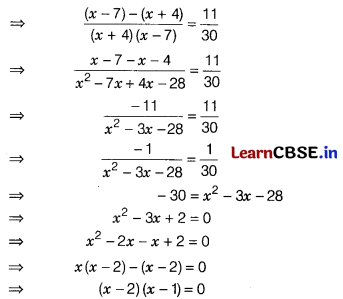
Hence, the roots of the given equation are 2 and 1.
Or
Solve for x, 2\(\left(\frac{2 x+3}{x-3}\right)\) – 25\(\left(\frac{x-3}{2 x+3}\right)\) = 5. [3]
Answer:
Let \(\frac{2 x+3}{x-3}\) = y
Then, \(\frac{x-3}{2 x+3}\) = \(\frac{1}{y}\)
Therefore, the given equation reduces to 2y-25— = 5
2y – 25\(\frac{1}{y}\) = 5
⇒ 2y
2
– 25 = 5y
⇒ 2y
2
– 5y – 25 = 0
⇒ 2y
2
– 10y + 5y – 25 = 0
⇒ 2y(y – 5) + 5(y – 5) = 0
⇒ (y – 5)(2y + 5) = 0 ⇒ y = 5
or y = \(\frac{-5}{2}\)
Now, putting y = 5 in Eq. (i), we get
\(\frac{2 x+3}{x-3}\) = \(\frac{5}{1}\)
⇒ 5x – 15 = 2x + 3
⇒ 3x = 18 ⇒ x = 6
Again, putting y = –\(\frac{5}{2}\) in Eq. (i), we get
\(\frac{2 x+3}{x-3}\) = –\(\frac{5}{2}\)
⇒ -5x + 15 = 4x + 6
∴ 9x = 9 ⇒ x = 1
Hence, the values of x are 1 and 6.
Question 28.
The sum of a two-digit number and the number obtained by reversing the digits is 66. If the digits of the number differ by 2, find the number. How many such numbers are there? [3]
OR
Solve: \(\frac{2}{\sqrt{x}}+\frac{3}{\sqrt{y}}\) = 2; \(\frac{4}{\sqrt{x}}-\frac{9}{\sqrt{y}}\) = -1
Solution:
Let the ten’s and the unit’s digits in the first number be x and y, respectively.
So, the original number = 10x + y
When the digits are reversed, x becomes the unit’s digit and y becomes the ten’s digits.
So, the obtain by reversing the digits = 10y + x
According to the given condition,
(10x + y) + (10y + x) = 66
i.e., 11(x + y) = 66
i.e., x + y = 6 …….. (i)
We are also given that the digits differ by 2,
Therefore, either x – y = 2 …….. (ii)
or y – x = 2 ……… (iii)
If x – y = 2, then solving (i) and (ii) by elimination, we get x = 4 and y = 2
In this case, we get the number 42.
If y – x = 2, then solving (i) and (iii), by elimination, we get x = 2 and y = 4
In this case, we get the number 24.
Thus, there are two such numbers 42 and 24.
OR
Let \(\frac{1}{\sqrt{x}}\) be ‘m’ \(\frac{1}{\sqrt{y}}\) be ‘n’
Then the given equations become
2m + 3n = 2
4m – 9n = -1
– 2(2m + 3n = 2) ⇒ – 4m – 6n= – 4 ……… (i)
4m – 9n = – 1 ………. (ii)
Adding (i) and (ii), we get
– 15n = – 5 ⇒ n = \(\frac{1}{3}\)
Substituting n = \(\frac{1}{3}\) in 2m + 3n = 2, we get
2m + 1 = 2
2m = 1
m = \(\frac{1}{2}\)
m = \(\frac{1}{2}\)
⇒ √x = 2
⇒ x = 4
and n = \(\frac{1}{3}\)
⇒ √y = 3
⇒ y = 9
Question 29.
Prove that [3]

Answer:
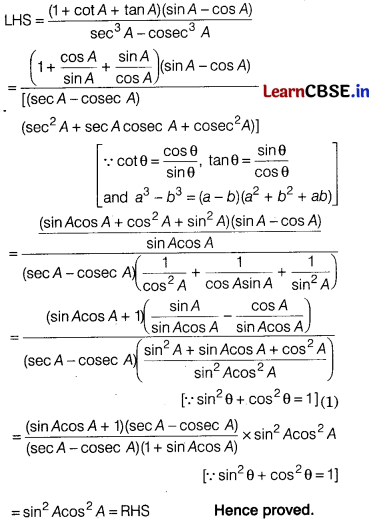
Question 30.
If 1 + sin
2
θ = 3 sin θ cos θ, then prove that tan θ = 1 or \(\frac{1}{2}\). [3]
Solution:
Given, 1 + sin
2
θ = 3 sin θ cos θ
Dividing both sides by cos
2
θ
\(\frac{1}{\cos ^2 \theta}\) + tan
2
θ = 3 tan θ
sec
2
θ + tan
2
= 3 tan θ
1 + tan
2
θ + tan
2
θ = 3 tan θ
1 + 2 tan
2
θ = 3 tan θ
2 tan
2
θ – 3 tan θ + 1 = θ
If tan θ = x, then the equation becomes 2x
2
– 3x + 1 = 0
⇒ (x – 1) (2x – 1) = 0; x = 1 or \(\frac{1}{2}\)
tan θ = 1 or \(\frac{1}{2}\) Hence proved
Question 31.
8 chairs and 5 tables for a classroom cost ₹ 10500, while 5 chairs and 3 tables cost ₹ 6450. Find the cost of each chair and that of each table. [3]
Answer:
Let the cost of each chair be ₹ x and cost of each table be ₹ y.
Then, 8x + 5y = 10500 ……… (i)
and 5x + 3y = 6450 …….. (ii)
On multiplying Eq. (ii) by 5 and Eq. (i) by 3 and subtracting the results, we get
25x – 24x = 32250 – 31500
⇒ x = 750
On putting x = 750 in Eq. (i), we get
8 × 750 + 5y = 10500
⇒ 6000 + 5y = 10500
⇒ 5y = 4500
⇒ y = 900
∴ Cost of each chair = ₹ 750
and cost of each table = ₹ 900
Section D
(Section D consists of 4 questions of 5 marks each)
Question 32.
A motor boat whose speed is 18 km/hr. in still water takes 1 hr. more to go 24 km upstream than to return downstream to the same spot. Find the speed of stream. [5]
OR
Two water taps together can fill a tank in 9\(\frac{3}{8}\) hours. The tap of larger diameter takes 10 hours less than the smaller one to fill the tank separately. Find the time in which each tap can separately fill the tank.
Solution:
Let the speed of the stream be x km/h.
The speed of the boat upstream = (18 – x) km/h
and The speed of the boat downstream = (18 + x) km/h.
The time taken to go upstream = \(\frac{\text { Distance }}{\text { Speed }}=\frac{24}{18-x}\) hours
The time taken to go downstream = \(\frac{\text { Distance }}{\text { Speed }}=\frac{24}{18+x}\) hours
According to the question,
\(\frac{24}{18-x}-\frac{24}{18+x}\) = 1
24 (18 + x) – 24 (18 – x) = (18 – x) (18 + x)
x
2
+ 48a – 324 = 0
x = 6 or – 54
Since x is the speed of the stream, it cannot be negative.
Therefore, x = 6 gives the speed of the stream = 6 km/h.
OR
Let the time taken by the smaller pipe to fill the tank = x hr.
Time taken by the larger pipe = (x – 10) hr.
Part of the tank filled by smaller pipe in 1 hour = \(\frac{1}{x}\)
Part of the tank filled by larger pipe in 1 hour = \(\frac{1}{x-10}\)
The tank can be filled in 9 \(\frac{3}{8}\) = \(\frac{75}{8}\) hours by both the pipes together.
Part of the tank filled by both the pipes in 1 hour = \(\frac{8}{75}\)
Therefore, \(\frac{1}{x}+\frac{1}{x-10}=\frac{8}{75}\)
75 (x – 10 + x) = 8x (x – 10)
75 (2x – 10) = 8x
2
– 80x
150x – 750 = 8x
2
– 80x
8x
2
– 230x + 750 = 0 (x – 25) (8x – 30) = 0
x = 25, \(\frac{30}{8}\)
Time taken by the smaller pipe cannot be \(\frac{30}{8}\) = 3.75 hours, as the time taken by the larger pipe will become negative, which is logically not possible.
Therefore, the time taken individually by the smaller pipe and the larger pipe will be 25 and 25 – 10 = 15 hours, respectively.
Question 33.
From a solid cylinder whose height is 12 cm and diameter is 10 cm, a conical cavity of same height and same diameter is hollowed out. Find the volume and total surface area of the remaining solid. [5]
Answer:
Given, radius of the cylinder, r = \(\frac{10}{2}\) = 5 cm and height of the cylinder, h = 12 cm

Now, volume of remaining solid = Volume of the cylinder – Volume of the cone
= \(\frac{6600}{7}\) – \(\frac{2200}{7}\) = \(\frac{4400}{7}\) = 628.57 cm
3
Since, slant height of the cone,
l = \(\sqrt{r^2+h^2}\) = \(\sqrt{(5)^2+(12)^2}\)
= \(\sqrt{169}\) = 13 cm
∴ Curved surface area of the cone = πrl
= \(\frac{22}{7}\) × 5 × 13 = \(\frac{1430}{7}\)cm
2
Curved surface area of the cylinder
= 2πrh
= 2 × \(\frac{22}{7}\) × 5 × 12 = \(\frac{2640}{7}\)cm
2
and area of upper base of the cylinder = m2
= \(\frac{22}{7}\) × 5 × 5 = \(\frac{550}{7}\) cm
2
Now, total surface area of the remaining solid = Curved surface area of the cylinder + Curved surface area of the cone + Area of upper base of the cylinder
= \(\frac{2640}{7}\) + \(\frac{1430}{7}\) + \(\frac{550}{7}\)
= \(\frac{4620}{7}\) = 660 cm
2
![]()
Question 34.
Water is flowing at the rate of 15 km/h through a pipe of diameter 14 cm into a cuboidal pond which is 50 m long and 44 m wide. In what time will the level of water in pond rise by 21 cm?
What should be the speed of water if the rise in water level is to be attained in 1 hour?
OR
A tent is in the shape of a cylinder surmounted by a conical top. If the height and radius of the cylindrical part are 3 m and 14 m respectively, and the total height of the tent is 13.5 m, find the area
of the canvas required for making the tent, keeping a provision of 26 m
2
of canvas for stitching and
wastage. Also, find the cost of the canvas to be purchased at the rate of 500 per m
2
. [5]
Solution:
Length of the pond, l = 50 m, width of the pond, b = 44 m
Water level is to rise by, h = 21 cm = \(\frac{21}{100}\) m
Volume of water in the pond= lbh =50 × 44 × \(\frac{21}{100}\)m
3
= 462m
3
Diameter of the pipe = 14 cm
Radius of the pipe, r = 7 cm = \(\frac{7}{100}\) m
Area of cross-section of pipe = πr
2
= \(\frac{22}{7}\) × \(\frac{7}{100}\) × \(\frac{7}{100}\) × \(\frac{154}{10000}\) m
2
Rate at which the water is flowing through the pipe, h = 15 km/h = 15000 m/h
Volume of water flowing in 1 hour = Area of cross-section of pipe x Height of water coming out
of pipe.
= (\(\frac{154}{10000}\) × 15000)m
3
Time required to fill the pond = \(\frac{\text { Volume of the pond }}{\text { Volume of water flowing in } 1 \text { hour }}\)
= \(\frac{462 \times 10000}{154 \times 15000}\) = 2 hours
Speed of water if the rise in water level is to be attained in 1 hour = 30 km/h.
OR

Radius of the cylindrical tent (r) = 14 m
Total height of the tent = 13.5 m
Height of the cyllinder =3 m
Height of the conical part = 10.5 m
Slant height of the cone (l) = \(\sqrt{h^2+r^2}\)
= \(\sqrt{(10.5)^2+(14)^2}\)
= \(\sqrt{110.25+196}\)
\(\sqrt{306.25}\) = 17.5m
Curved surface area of cylindrical portion = 2πrh
= 2 × \(\frac{22}{7}\) × 14 × 3 = 264 m
2
Curved surface area of conical portion = πrl
= \(\frac{22}{7}\) × 14 × 17.5 = 770 m
2
Total curved surface area = 264 m
2
+ 770 m
2
= 1034 m
2
Provision for stitching and wastage = 26 m
2
Area of canvas to be purchased = 1034 + 26 = 1060 m
2
Cost of canvas = Rate × Surface area
= 500 × 1060 = ₹5,30,000
Question 35.
In the given figure, CM and RN are respectively the medians of ∆ABC and ∆PQR. If ∆ABC ~ ∆PQR, then prove that
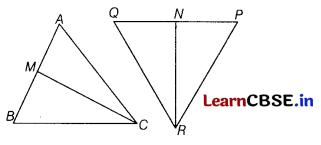
(a) ∆AMC ~ ∆PNR
(b) \(\frac{C M}{R N}\) = \(\frac{A B}{P Q}\)
(c) ∆CMB ~ ∆RNQ [5]
Answer:
Given ∆ABC ~ ∆PQR
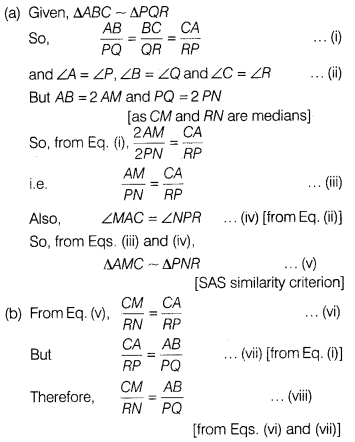
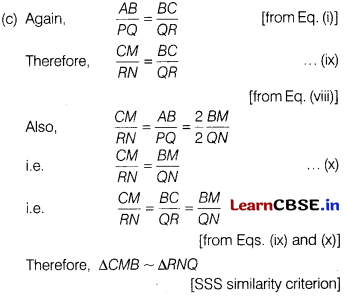
![]()
Section E
(Case study based questions are compulsory)
Question 36.
Manpreet Kaur is the national record holder for women in the shot-put discipline. Her throw of 18.86 m at the Asian Grand Prix in 2017 is the biggest distance for an Indian female athlete.

Keeping her as a role model, Sanjitha is determined to earn gold in Olympics on day.
Initially her throw reached 7.56 m only. Being an athlete in school, she regularly practiced both in the mornings and in the evenings and was able to improve the distance by 9 cm every week.
During the special camp for 15 days, she started with 40 throws and every day kept increasing the
number of throws by 12 to achieve this remarkable progress.
(i) How may throws Sanjitha practiced on 11
th
day of the camp? [1]
(ii) What would be sanjitha’s throw distance at the end of 6 months? [2]
OR
When will she be able to achieve a throw of 11.16 m?
(iii) How many throws did she do during the entire camp of 15 days? [1]
Solution:
(i) Number of throws during camp, a = 40; d = 12
t
11
= a + 10d
= 40 + 10 × 12 = 160 throws
(ii) a = 7.56 m; d = 9 cm = 0.09 m
n = 6 weeks
t
n
= a + (n – 1) d
= 7.56 + 6 (0.09) = 7.56 + 0.54
Sanjitha’s throw distance at the end of 6 weeks = 8.1 m
OR
a = 7.56 m; d = 9 cm = 0.09 m
t
n
= 11.16 m
t
n
= a + (n – 1) d
11.16 = 7.56 + (n – 1) (0.09)
3.6 = (n – 1) (0.09)
n – 1 = \(\frac{3.6}{0.09}\) = 40
n = 41
Sanjitha’s will be able to throw 11.16 m in 41 weeks.
(iii) a = 40; d = 12; n = 15
S
n
= \(\frac{n}{2}\) [2a + (n – 1) d]
S
n
= \(\frac{15}{2}\) [2(40)+ (15 – 1) (12)]
= \(\frac{15}{2}\) [80 + 168] = \(\frac{15}{2}\) [248] = 1860 throws
Question 37.
A School Boy
Delhi Public School Society has so many schools in different cities of India. One of the branch of Delhi Public School is in Ghaziabad. In that school thousand of students study in the classroom.
Out of them one of the boys is standing in the ground having coordinates (4, 1) facing towards East. He moves 4 units in straight line, then turns left and moves 3 units and stops. Now, he is at his home.
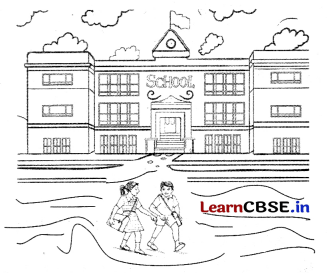
The representation of the above situation on the coordinate axes is shown below

Based on the above information, answer the following questions
(i) Find the area of ∆ABC. (1)
Answer:
∴ Area of ∆ABC = \(\frac{1}{2}\) × AB × BC
= \(\frac{1}{2}\) × 4 × 3
= 6 sq units
(ii) If we draw perpendicular lines from points A and B to the X-axis, then find the region covered by these perpendicular lines. (1)
Answer:
When, we draw perpendicular lines from the points, a rectangle is formed.
∴ Area of covered region = l × b
= 4 × 1 = 4 sq units
(iii) What is the shortest distance between his school and house? (2)
Answer:
From the given figure, shortest distance between school and house = AC
= \(\sqrt{(8-4)^2+(4-1)^2}\)
[from distance formula]
= \(\sqrt{4^2+3^2}\) = \(\sqrt{16+9}\)
= \(\sqrt{25}\) = 5 units
∴ Shortest distance = 5 units
Or
Suppose point D divides the line segment AB in the ratio 1:2, then find the coordinates of D. (2)
Answer:
By using the internal section formula,

The coordinates of D
= \(\left(\frac{1 \times 8+2 \times 4}{1+2}, \frac{1 \times 1+2 \times 1}{1+2}\right)\)
= \(\left(\frac{8+8}{3}, \frac{1+2}{3}\right)\) = \(\left(\frac{16}{3}, \frac{3}{3}\right)\) = \(\left(\frac{16}{3}, 1\right)\)
![]()
Question 38.
One evening, Kaushik was in a park. Children were playing cricket. Birds were singing on a nearby tree of height 80 m. He observed a bird on the tree at an angle of elevation of 45°.
When a sixer was hit, a ball flew through the tree frightening the bird to fly away. In 2 seconds, he observed the bird flying at the same height at an angle of elevation of 30° and the ball flying towards him at the same height at an angle of elevation of 60°.

(i) At what distance from the foot of the tree was he observing the bird sitting on the tree? [1]
(ii) How far did the bird fly in the mentioned time? [2]
OR
After hitting the tree, how far did the ball travel in the sky when Kaushik saw the ball?
(iii) What is the speed of the bird in m/min if it had flown 20(√3 + 1) m? [1]
Solution:
